Optimal Energy Management System of IoT-Enabled Large Building Considering Electric Vehicle Scheduling, Distributed Resources, and Demand Response Schemes
Abstract
:1. Introduction
2. Literature Review
- Optimal scheduling of the proposed system considering the various types of demand response.
- EV-based charging and discharging modeling is considered for the real-time analysis of smart buildings in developing countries.
- The effect of different demand responses on the operational cost of the building is analyzed.
- In the next section, the system description is presented considering the main objective of the proposed model.
3. System Description
3.1. Demand Response Type
3.1.1. Time of Use (ToU) Pricing
3.1.2. Critical Peak Pricing (CPP)
3.1.3. Real-Time Pricing (RTP)
3.2. Photovoltaic System
3.3. Energy Storage System (ESS)
3.4. Electric Vehicles (EVs)
4. Mathematical Modeling
4.1. PV Modeling
4.2. Energy Storage Modeling
4.3. EV Constraints
4.4. Grid Connection
4.4.1. Objective Function
4.4.2. Solution Methodology
5. Results and Discussion
5.1. Case 01, Analysis Based on Real-Time Pricing
- i.
- Without Scheduling
- ii.
- With Proposed Scheduling
5.2. Case 02, Analysis Based on Critical Peak Pricing
- i.
- Without Scheduling
- ii.
- With Proposed Scheduling
5.3. Case 03, Analysis Based on Time of Use Pricing
- i.
- Without Scheduling
- ii.
- With Proposed Scheduling
6. Conclusions
Author Contributions
Funding
Institutional Review Board Statement
Informed Consent Statement
Data Availability Statement
Acknowledgments
Conflicts of Interest
References
- Muqeet, H.A.; Javed, H.; Akhter, M.N.; Shahzad, M.; Munir, H.M.; Nadeem, M.U.; Bukhari, S.S.H.; Huba, M. Sustainable Solutions for Advanced Energy Management System of Campus Microgrids: Model Opportunities and Future Challenges. Sensors 2022, 22, 2345. [Google Scholar] [CrossRef] [PubMed]
- Gulzar, M.M.; Iqbal, M.; Shahzad, S.; Muqeet, H.A.; Shahzad, M.; Hussain, M.M. Load Frequency Control (LFC) Strategies in Renewable Energy-Based Hybrid Power Systems: A Review. Energies 2022, 15, 3488. [Google Scholar] [CrossRef]
- Muqeet, H.A.; Munir, H.M.; Javed, H.; Shahzad, M.; Jamil, M.; Guerrero, J.M. An Energy Management System of Campus Microgrids: State-of-the-Art and Future Challenges. Energies 2021, 14, 6525. [Google Scholar] [CrossRef]
- Iqbal, M.M.; Sajjad, I.A.; Nadeem Khan, M.F.; Liaqat, R.; Shah, M.A.; Muqeet, H.A. Energy Management in Smart Homes with PV Generation, Energy Storage and Home to Grid Energy Exchange. In Proceedings of the 2019 International Conference on Electrical, Communication, and Computer Engineering (ICECCE), Swat, Pakistan, 24–25 July 2019; pp. 1–7. [Google Scholar] [CrossRef]
- Iqbal, M.M.; Waseem, M.; Manan, A.; Liaqat, R.; Muqeet, A.; Wasaya, A. IoT-Enabled Smart Home Energy Management Strategy for DR Actions in Smart Grid Paradigm. In Proceedings of the 2021 International Bhurban Conference on Applied Sciences and Technologies (IBCAST), Islamabad, Pakistan, 12–16 January 2021; pp. 352–357. [Google Scholar] [CrossRef]
- Alhasnawi, B.N.; Jasim, B.H. A new internet of things enabled trust distributed emand side management system. Sustain. Energy Technol. Assess. 2021, 46, 101272. [Google Scholar] [CrossRef]
- Ponnusamy, V.K.; Kasinathan, P.; Madurai Elavarasan, R.; Ramanathan, V.; Anandan, R.K.; Subramaniam, U.; Ghosh, A.; Hossain, E. A comprehensive review on sustainable aspects of big data analytics for the smart grid. Sustainability 2021, 13, 13322. [Google Scholar] [CrossRef]
- Silva, M.; Fernandes, F.; Morais, H.; Ramos, S.; Vale, Z. Hour-ahead energy resource management in university campus microgrid. In Proceedings of the 2015 IEEE Eindhoven PowerTech, Eindhoven, The Netherlands, 29 June–2 July 2015; pp. 1–6. [Google Scholar] [CrossRef]
- Somakumar, R.; Kasinathan, P.; Monicka, G.; Rajagopalan, A.; Ramachandaramurthy, V.K.; Subramaniam, U. Optimization of emission cost and economic analysis for microgrid by considering a metaheuristic algorithm-assisted dispatch model. Int. J. Numer. Model. Electron. Netw. Devices Fields 2022, 35, 15. [Google Scholar] [CrossRef]
- Rochd, A.; Benazzouz, A.; Abdelmoula, I.A.; Raihani, A.; Ghennioui, A.; Naimi, Z.; Ikken, B. Design and implementation of an AI-based & IoT-enabled Home Energy Management System: A case study in Benguerir—Morocco. Energy Rep. 2021, 7, 699–719. [Google Scholar] [CrossRef]
- Estebsari, A.; Mazzarino, P.R.; Bottaccioli, L.; Patti, E. IoT-Enabled Real-Time Management of Smart Grids with Demand Response Aggregators. IEEE Trans. Ind. Appl. 2022, 58, 102–112. [Google Scholar] [CrossRef]
- Ahmadzadeh, S.; Parr, G.; Zhao, W. A Review on Communication Aspects of Demand Response Management for Future 5G IoT- Based Smart Grids. IEEE Access 2021, 9, 77555–77571. [Google Scholar] [CrossRef]
- Abd ul Muqeet, H.; Ahmad, A. An Optimal Operation of Prosumer Microgrid Considering Demand Response Strategies and Battery Life. Tech. J. 2020, 25, 41–51. [Google Scholar]
- Muqeet, A.A.H.A.; Ahmad, A. Optimal Day-Ahead Operation of Microgrid Considering Demand Response and Battery Strategies for Prosumer Community. Tech. J. UET Taxila 2020, 25, 1–13. [Google Scholar]
- Mehmood, M.Y.; Oad, A.; Abrar, M.; Munir, H.M.; Hasan, S.F.; Muqeet, H.; Golilarz, N.A. Edge Computing for IoT-Enabled Smart Grid. Secur. Commun. Netw. 2021, 2021, 5524025. [Google Scholar] [CrossRef]
- Shahab, M.; Wang, S.; Abd ul Muqeet, H. Advanced Optimal Design of the IoT Based University Campus Microgrid Considering Environmental Concerns and Demand Response. In Proceedings of the 2021 6th International Conference on Power and Renewable Energy (ICPRE), Shanghai, China, 17–20 September 2021. [Google Scholar]
- Zhao, L.; Wang, J.; Liu, J.; Kato, N. Routing for crowd management in smart cities: A deep reinforcement learning perspective. IEEE Commun. Mag. 2019, 57, 88–93. [Google Scholar] [CrossRef]
- Muqeet, H.A.; Sajjad, I.A.; Ahmad, A.; Iqbal, M.M.; Ali, S.; Guerrero, J.M. Optimal Operation of Enegy Storage System for a Prosumer Microgrid Considering Economical and Environmental Effects. In Proceedings of the 2019 International Symposium on Recent Advances in Electrical Engineering (RAEE), Islamabad, Pakistan, 28–29 August 2019. [Google Scholar]
- Nasir, T.; Bukhari, S.S.H.; Raza, S.; Munir, H.M.; Abrar, M.; Bhatti, K.L.; Ro, J.S.; Masroor, R. Recent Challenges and Methodologies in Smart Grid Demand Side Management: State of the Art Literature Review. Math. Probl. Eng. 2021, 2021, 5821301. [Google Scholar] [CrossRef]
- Javed, H.; Muqeet, H.A. Design, Model & Planning of Prosumer Microgrid for MNSUET Multan Campus. Sir Syed Univ. Res. J. Eng. Technol. 2021, 11, 1–7. [Google Scholar]
- Bin, L.; Shahzad, M.; Javed, H.; Muqeet, H.A.; Akhter, M.N.; Liaqat, R.; Hussain, M.M. Scheduling and Sizing of Campus Microgrid Considering Demand Response and Economic Analysis. Sensors 2022, 22, 6150. [Google Scholar] [CrossRef]
- Sharda, S.; Singh, M.; Sharma, K. Demand side management through load shifting in IoT based HEMS: Overview, challenges and opportunities. Sustain. Cities Soc. 2021, 65, 102517. [Google Scholar] [CrossRef]
- Alhasnawi, B.N.; Jasim, B.H.; Siano, P.; Guerrero, J.M. A novel real-time electricity scheduling for home energy management system using the internet of energy. Energies 2021, 14, 3191. [Google Scholar] [CrossRef]
- Wu, Y.; Wu, Y.; Guerrero, J.M.; Vasquez, J.C. A comprehensive overview of framework for developing sustainable energy internet: From things-based energy network to services-based management system. Renew. Sustain. Energy Rev. 2021, 150, 111409. [Google Scholar] [CrossRef]
- Jalilian, F.; Mirzaei, M.A.; Zare, K.; Mohammadi-Ivatloo, B.; Marzband, M.; Anvari-Moghaddam, A. Multi-energy microgrids: An optimal despatch model for water-energy exus. Sustain. Cities Soc. 2022, 77, 103573. [Google Scholar] [CrossRef]
- Vahedipour-Dahraie, M.; Rashidizadeh-Kermani, H.; Anvari-Moghaddam, A.; Siano, P.; Catalão, J.P.S. Short-term reliability and economic evaluation of resilient microgrids under incentive-based demand response programs. Int. J. Electr. Power Energy Syst. 2022, 138, 107918. [Google Scholar] [CrossRef]
- Nasir, T.; Raza, S.; Abrar, M.; Muqeet, H.A.; Jamil, H.; Qayyum, F.; Cheikhrouhou, O.; Alassery, F.; Hamam, H. Optimal scheduling of campus microgrid considering the electric vehicle integration in smart grid. Sensors 2021, 21, 7133. [Google Scholar] [CrossRef] [PubMed]
- Brenna, M.; Foiadelli, F.; Longo, M.; Bracco, S.; Delfino, F. Smart microgrids in smart campuses with electric vehicles and storage systems: Analysis of possible operating scenarios. In Proceedings of the 2016 IEEE International Smart Cities Conference (ISC2), Trento, Italy, 12–15 September 2016; pp. 1–6. [Google Scholar] [CrossRef]
- Obara, S.; Morizane, Y.; Morel, J. A study of small-scale energy networks of the Japanese Syowa Base in Antarctica by distributed engine generators. Appl. Energy 2013, 111, 113–128. [Google Scholar] [CrossRef]
- Angelim, J.H.; Affonso, C.M. Energy management on university campus with photovoltaic generation and BESS using simulated annealing. In Proceedings of the 2018 IEEE Texas Power and Energy Conference TPEC, College Station, TX, USA, 8–9 February 2018; pp. 1–6. [Google Scholar] [CrossRef]
- Kumar, A.; Singh, A.R.; Deng, Y.; He, X.; Kumar, P.; Bansal, R.C. Multiyear load growth based techno-financial evaluation of a microgrid for an academic institution. IEEE Access 2018, 6, 37533–37555. [Google Scholar] [CrossRef]
- Xu, F.; Wu, W.; Zhao, F.; Zhou, Y.; Wang, Y.; Wu, R.; Zhang, T.; Wen, Y.; Fan, Y.; Jiang, S. A micro-market module design for university demand-side management using self-crossover genetic algorithms. Appl. Energy 2019, 252, 113456. [Google Scholar] [CrossRef]
- Redondo-Iglesias, E.; Venet, P.; Pelissier, S. Global model for self-discharge and capacity fade in lithium-ion batteries based on the generalized eyring relationship. IEEE Trans. Veh. Technol. 2018, 67, 104–113. [Google Scholar] [CrossRef]
- Pandžić, H.; Bobanac, V. An accurate charging model of battery energy storage. IEEE Trans. Power Syst. 2019, 34, 1416–1426. [Google Scholar] [CrossRef]
- Sorourifar, F.; Zavala, V.M.; Dowling, A.W. Integrated Multiscale Design, Market Participation, and Replacement Strategies for Battery Energy Storage Systems. IEEE Trans. Sustain. Energy 2020, 11, 84–92. [Google Scholar] [CrossRef]
- Parvini, Y.; Vahidi, A.; Fayazi, S.A. Heuristic Versus Optimal Charging of Supercapacitors, Lithium-Ion, and Lead-Acid Batteries: An Efficiency Point of View. IEEE Trans. Control Syst. Technol. 2018, 26, 167–180. [Google Scholar] [CrossRef]
- Mohamed, F.A.; Koivo, H.N. System modelling and online optimal management of microgrid with battery storage. Renew. Energy Power Qual. J. 2007, 1, 74–78. [Google Scholar] [CrossRef]
- Hesse, H.C.; Schimpe, M.; Kucevic, D.; Jossen, A. Lithium-ion battery storage for the grid—A review of stationary battery storage system design tailored for applications in modern power grids. Energies 2017, 10, 2107. [Google Scholar] [CrossRef]
- Rancilio, G.; Lucas, A.; Kotsakis, E.; Fulli, G.; Merlo, M.; Delfanti, M.; Masera, M. Modeling a large-scale battery energy storage system for power grid application analysis. Energies 2019, 12, 3312. [Google Scholar] [CrossRef]
- Ahsan, A.; Zhao, Q.; Khambadkone, A.M.; Chia, M.H. Dynamic battery operational cost modeling for energy dispatch. In Proceedings of the 2016 IEEE Energy Conversion Congress and Exposition (ECCE), Milwaukee, WI, USA, 18–22 September 2016; pp. 1–5. [Google Scholar] [CrossRef]
- Xiong, B.; Zhang, H.; Deng, X.; Tang, J. State of charge estimation based on sliding mode observer for vanadium redox flow battery. In Proceedings of the 2017 IEEE Power & Energy Society General Meeting, Chicago, IL, USA, 16–20 July 2018; pp. 1–5. [Google Scholar] [CrossRef]
- Hossain, M.A.; Pota, H.R.; Squartini, S.; Zaman, F.; Guerrero, J.M. Energy scheduling of community microgrid with battery cost using particle swarm optimisation. Appl. Energy 2019, 254, 113723. [Google Scholar] [CrossRef]
- Sufyan, M.; Rahim, N.A.; Tan, C.K.; Muhammad, M.A.; Raihan, S.R.S. Optimal sizing and energy scheduling of isolated microgrid considering the battery lifetime degradation. PLoS ONE 2019, 14, e0211642. [Google Scholar] [CrossRef] [PubMed]
- Shareef, H.; Ahmed, M.S.; Mohamed, A.; Al Hassan, E. Review on Home Energy Management System Considering Demand Responses, Smart Technologies, and Intelligent Controllers. IEEE Access 2018, 6, 24498–24509. [Google Scholar] [CrossRef]
- Esmaeili, S.; Anvari-Moghaddam, A.; Jadid, S. Optimal Operation scheduling of a Microgrid Incorporating Battery Swapping Stations. IEEE Trans. Power Syst. 2019, 34, 5063–5072. [Google Scholar] [CrossRef]
- Zacharia, L.; Tziovani, L.; Savva, M.; Hadjidemetriou, L.; Kyriakides, E.; Bintoudi, A.D.; Tsolakis, A.; Tzovaras, D.; Martinez-Ramos, J.L.; Marano, A.; et al. Optimal Energy Management and Scheduling of a Microgrid in Grid-Connected and Islanded Modes. In Proceedings of the 2019 International Conference on Smart Energy Systems and Technologies (SEST), Porto, Portugal, 9–11 September 2019. [Google Scholar] [CrossRef]
- Singh, R.; Kumar, K.N.; Sivaneasan, B.; So, P.; Gooi, H.B.; Jadhav, N.; Marnay, C. Sustainable Campus with PEV and Microgrid; Lawrence Berkeley National Laboratory: Berkeley, CA, USA, 2012; pp. 128–139. [Google Scholar]
- Reyasudin Basir Khan, M.; Pasupuleti, J.; Al-Fattah, J.; Tahmasebi, M. Optimal grid-connected PV system for a campus microgrid. Indones. J. Electr. Eng. Comput. Sci. 2018, 12, 899–906. [Google Scholar] [CrossRef]
- Simmhan, Y.; Prasanna, V.; Aman, S.; Natarajan, S.; Yin, W.; Zhou, Q. Demo Abstract: Toward Data-Driven Demand-Response Optimization in a Campus Microgrid. In Proceedings of the Third ACM Workshop on Embedded Sensing Systems for Energy-Efficiency in Buildings, Seattle, WA, USA, 1 November 2011. [Google Scholar]
- Hussain, A.; Bui, V.H.; Kim, H.M.; Im, Y.H.; Lee, J.Y. Optimal energy management of combined cooling, heat and power in different demand type buildings considering seasonal demand variations. Energies 2017, 10, 789. [Google Scholar] [CrossRef]
- Shahidehpour, M.; Khodayar, M.; Barati, M. Campus microgrid: High reliability for active distribution systems. In Proceedings of the 2012 IEEE Power and Energy Society General Meeting, San Diego, CA, USA, 22–26 July 2012; pp. 1–2. [Google Scholar] [CrossRef]
- Chanda, S.; Venkataramanan, V.; Srivastava, A.K. Real time modeling and simulation of campus microgrid for voltage analysis. In Proceedings of the 2014 North American Power Symposium (NAPS), Pullman, WA, USA, 7–9 September 2014; pp. 1–6. [Google Scholar] [CrossRef]
- Bracco, S.; Brignone, M.; Delfino, F.; Procopio, R. An energy management system for the savona campus smart polygeneration microgrid. IEEE Syst. J. 2017, 11, 1799–1809. [Google Scholar] [CrossRef]
- Muqeet, H.A.; Ahmad, A.; Sajjad, I.A.; Liaqat, R.; Raza, A.; Iqbal, M.M. Benefits of Distributed Energy and Storage System in Prosumer Based Electricity Market. In Proceedings of the 2019 IEEE International Conference on Environment and Electrical Engineering and 2019 IEEE Industrial and Commercial Power Systems Europe (EEEIC/I & CPS Europe), Genova, Italy, 11–14 June 2019. [Google Scholar] [CrossRef]
- Abbas, Z.; Harijan, K.; Shaikh, P.H.; Walasai, G.D.; Ali, F. Effect of Ambient Temperature and Relative Humidity on Solar PV System Performance: A case study of Quaid-e-Azam Solar Park, Pakistan. Sindh Univ. Res. J. 2017, 49, 721–726. [Google Scholar] [CrossRef]
- Harijan, K.; Uqaili, M.A.; Mirza, U.K. Assessment of Solar PV Power Generation Potential in Pakistan. J. Clean Energy Technol. 2015, 3, 54–56. [Google Scholar] [CrossRef]
- Zhang, L.; Harnefors, L.; Nee, H.P. Power-Synchronization Control of Grid-Connected. IEEE Trans. Power Syst. 2010, 25, 809–820. [Google Scholar] [CrossRef]
- Chen, C.; Duan, S.; Cai, T.; Liu, B.; Hu, G. Optimal allocation and economic analysis of energy storage system in microgrids. IEEE Trans. Power Electron. 2011, 26, 2762–2773. [Google Scholar] [CrossRef]
- Bahrani, B.; Saeedifard, M.; Karimi, A.; Rufer, A. A multivariable design methodology for voltage control of a single-DG-unit microgrid. IEEE Trans. Ind. Inform. 2013, 9, 589–599. [Google Scholar] [CrossRef]
- Microgrid, H.; Valverde, L.; Rosa, F.; Bordons, C. Design, Planning and Management of a Hydrogen-Based Microgrid. IEEE Trans. Ind. Inform. 2013, 9, 1398–1404. [Google Scholar]
- Di Silvestre, M.L.; Graditi, G.; Riva Sanseverino, E. A generalized framework for optimal sizing of distributed energy resources in micro-grids using an indicator-based swarm approach. IEEE Trans. Ind. Inform. 2014, 10, 152. [Google Scholar] [CrossRef]
- Divya, K.C.; Østergaard, J. Battery energy storage technology for power systems-An overview. Electr. Power Syst. Res. 2009, 79, 511–520. [Google Scholar] [CrossRef]
- Jing, W.; Lai, C.H.; Wong, S.H.W.; Wong, M.L.D. Battery-supercapacitor hybrid energy storage system in standalone DC microgrids: Areview. IET Renew. Power Gener. 2017, 11, 461–469. [Google Scholar] [CrossRef]
- Huang, S.C.; Tseng, K.H.; Liang, J.W.; Chang, C.L.; Pecht, M.G. An online SOC and SOH estimation model for lithium-ion batteries. Energies 2017, 10, 512. [Google Scholar] [CrossRef]
- Dia, H.; Javanshour, F. Autonomous Shared Mobility-On-Demand: Melbourne Pilot Simulation Study. Transp. Res. Procedia 2017, 22, 285–296. [Google Scholar] [CrossRef]
- Friedrich, B. Technische, rechtliche und gesellschaftliche Aspekte. In Autonomes Fahren; Springer: Berlin/Heidelberg, Germany, 2015. [Google Scholar] [CrossRef]
- Al-Badi, A.H.; Ahshan, R.; Hosseinzadeh, N.; Ghorbani, R.; Hossain, E. Survey of smart grid concepts and technological demonstrations worldwide emphasizing on the Oman perspective. Appl. Syst. Innov. 2020, 3, 5. [Google Scholar] [CrossRef]
- Kristiawan, R.B.; Widiastuti, I.; Suharno, S. Technical and economical feasibility analysis of photovoltaic power installation on a university campus in Indonesia. MATEC Web Conf. 2018, 197, 08012. [Google Scholar] [CrossRef] [Green Version]
- Muqeet, H.A.U.; Ahmad, A. Optimal scheduling for campus prosumer microgrid considering price based demand response. IEEE Access 2020, 8, 71378–71394. [Google Scholar] [CrossRef]
- Abd Ul Muqeet, H.; Munir, H.M.; Ahmad, A.; Sajjad, I.A.; Jiang, G.J.; Chen, H.X. Optimal Operation of the Campus Microgrid considering the Resource Uncertainty and Demand Response Schemes. Math. Probl. Eng. 2021, 2021, 5569701. [Google Scholar] [CrossRef]
- Aluisio, B.; Dicorato, M.; Ferrini, I.; Forte, G.; Sbrizzai, R.; Trovato, M. Optimal sizing procedure for electric vehicle supply infrastructure based on DC microgrid with station commitment. Energies 2019, 12, 1901. [Google Scholar] [CrossRef]
- Bhatti, A.R.; Salam, Z.; Sultana, B.; Rasheed, N.; Awan, A.B.; Sultana, U.; Younas, M. Optimized sizing of photovoltaic grid-connected electric vehicle charging system using particle swarm optimization. Int. J. Energy Res. 2019, 43, 500–522. [Google Scholar] [CrossRef]
- Saleem, Y.; Crespi, N.; Rehmani, M.H.; Copeland, R. Internet of Things-Aided Smart Grid: Technologies, Architectures, Applications, Prototypes, and Future Research Directions. IEEE Access 2019, 7, 62962–63003. [Google Scholar] [CrossRef]
- Gao, H.C.; Choi, J.H.; Yun, S.Y.; Lee, H.J.; Ahn, S.J. Optimal scheduling and real-time control schemes of battery energy storage system for microgrids considering contract demand and forecast uncertainty. Energies 2018, 11, 1371. [Google Scholar] [CrossRef]
- Vahedipour-Dahraie, M.; Rashidizadeh-Kermani, H.; Anvari-Moghaddam, A.; Guerrero, J.M. Stochastic Frequency-Security Constrained Scheduling of a Microgrid Considering Price-Driven Demand Response. In Proceedings of the 2018 International Symposium on Power Electronics, Electrical Drives, Automation and Motion (SPEEDAM), Amalfi, Italy, 20–22 June 2018; pp. 716–721. [Google Scholar] [CrossRef]
- Nasir, M.; Khan, H.A.; Khan, I.; ul Hassan, N.; Zaffar, N.A. Grid load reduction through optimized PV power utilization in intermittent grids using a low-cost hardware platform. Energies 2019, 12, 1764. [Google Scholar] [CrossRef]
- Azimian, M.; Amir, V.; Javadi, S. Economic and Environmental Policy Analysis for Emission-Neutral Multi-Carrier Microgrid Deployment. Appl. Energy 2020, 277, 115609. [Google Scholar] [CrossRef]
- Ul Hassan Hashmi, S.; Ulasyar, A.; Zad, H.S.; Khattak, A.; Imran, K. Optimal Day-Ahead Scheduling for Campus Microgrid by using MILP Approach. Pak. J. Eng. Technol. PakJET 2021, 4, 21–27. [Google Scholar] [CrossRef]
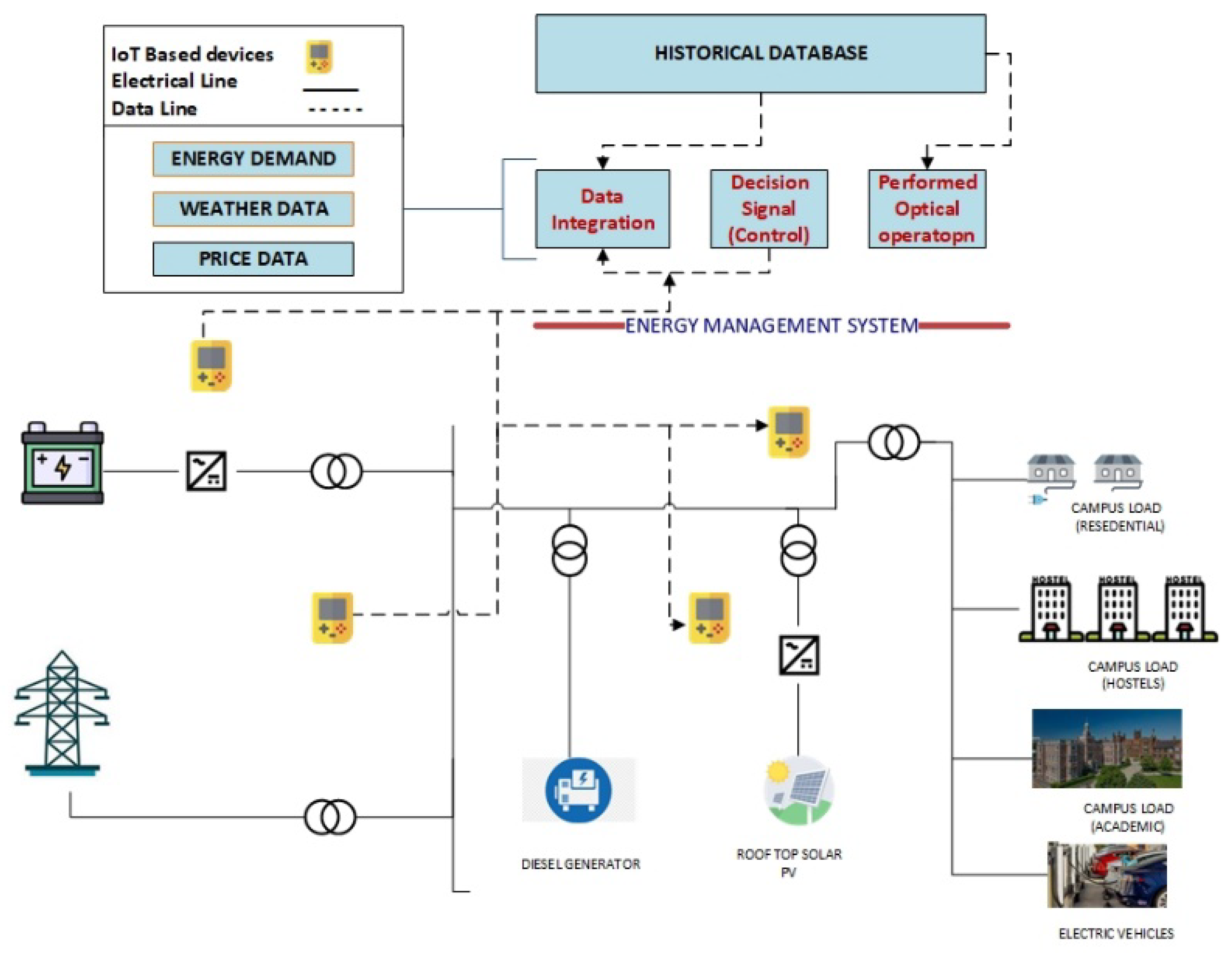

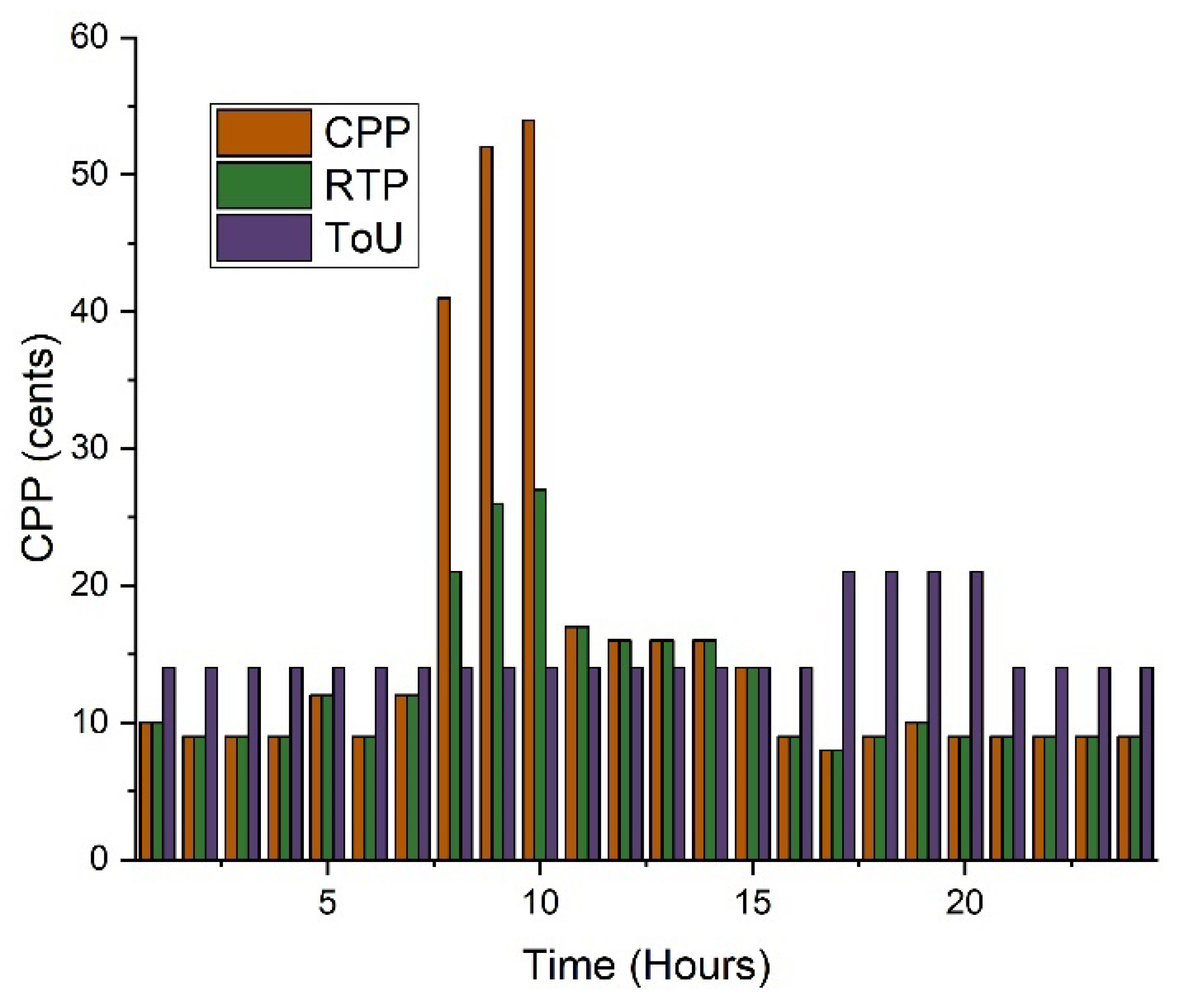




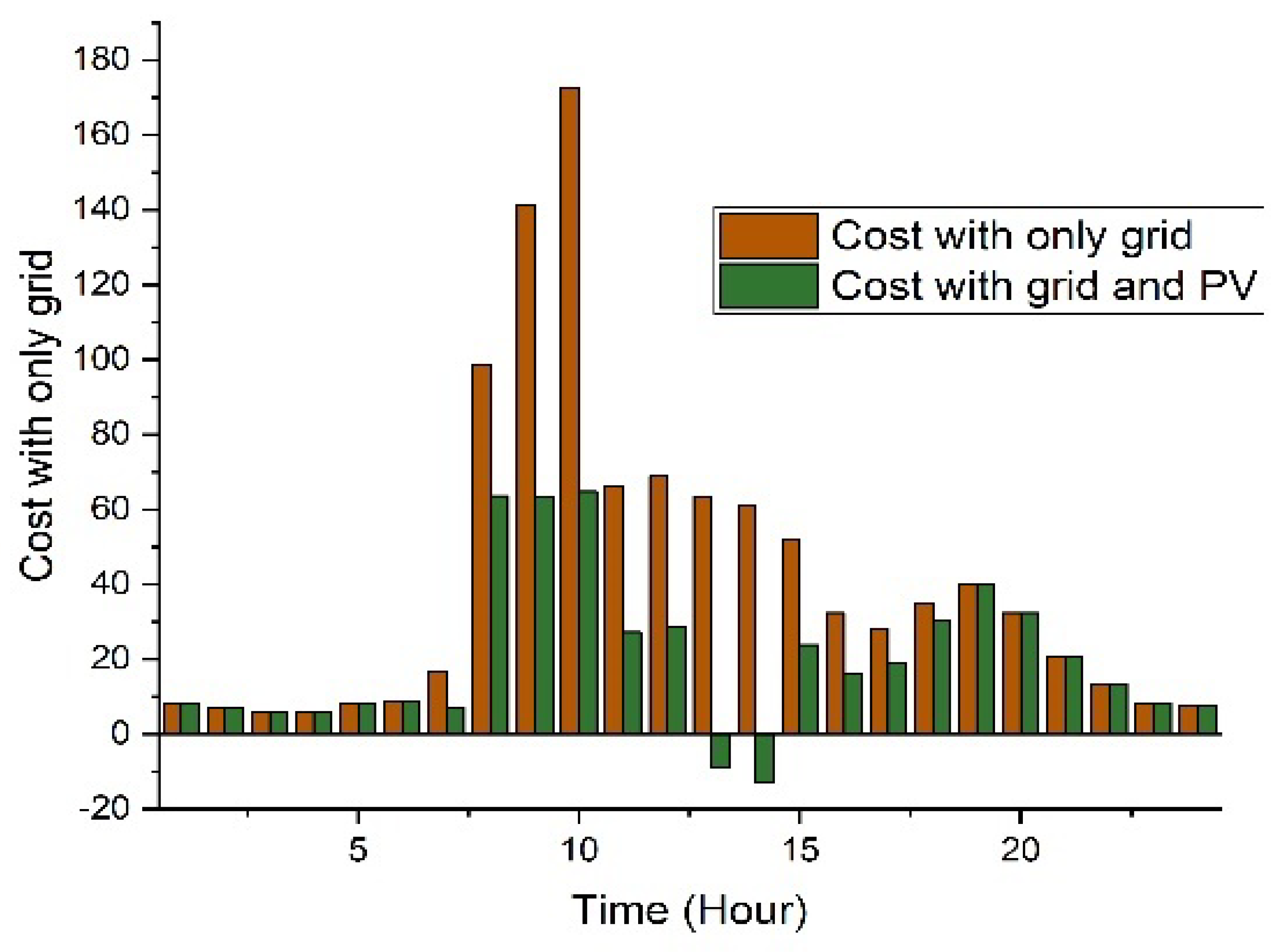
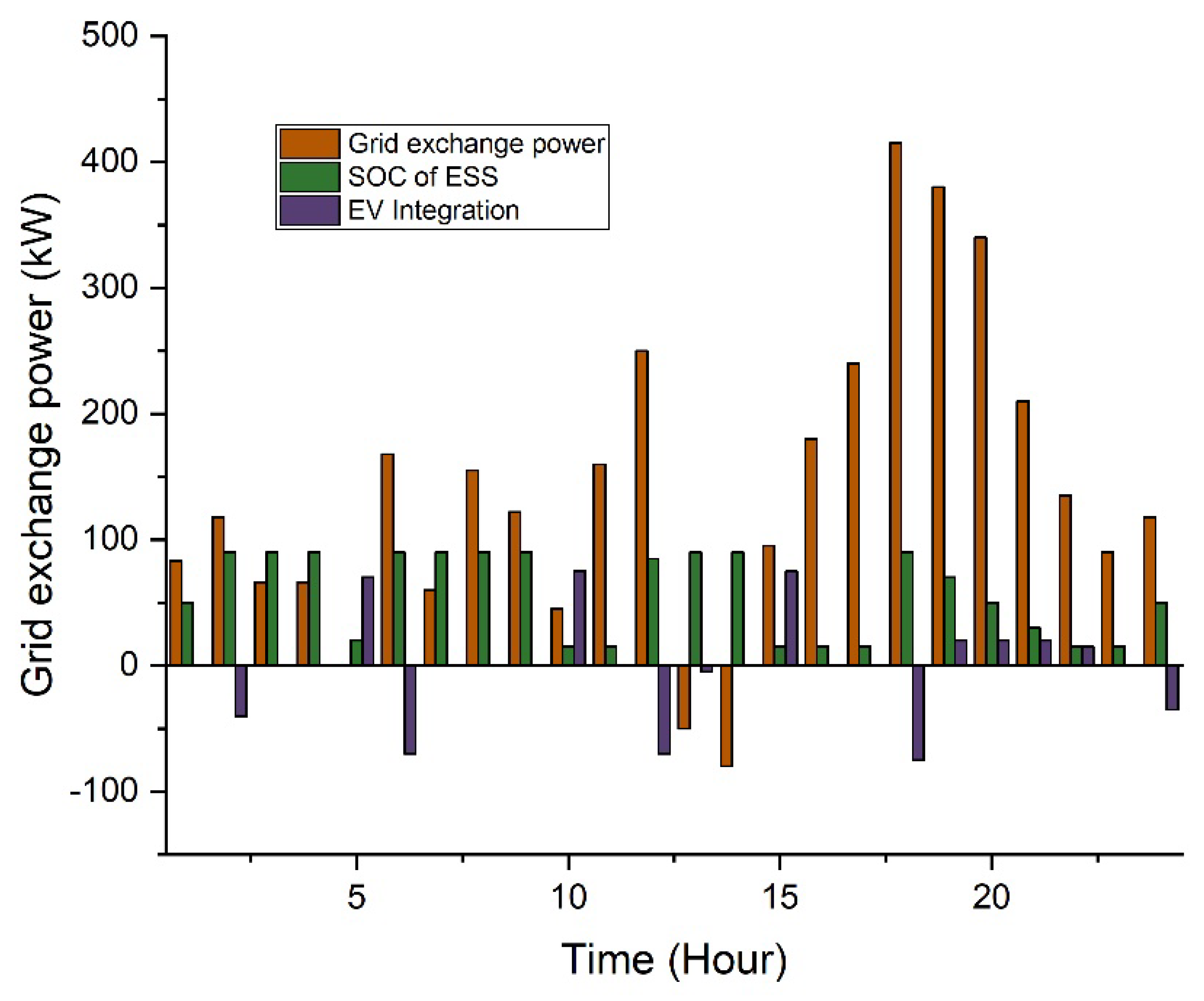

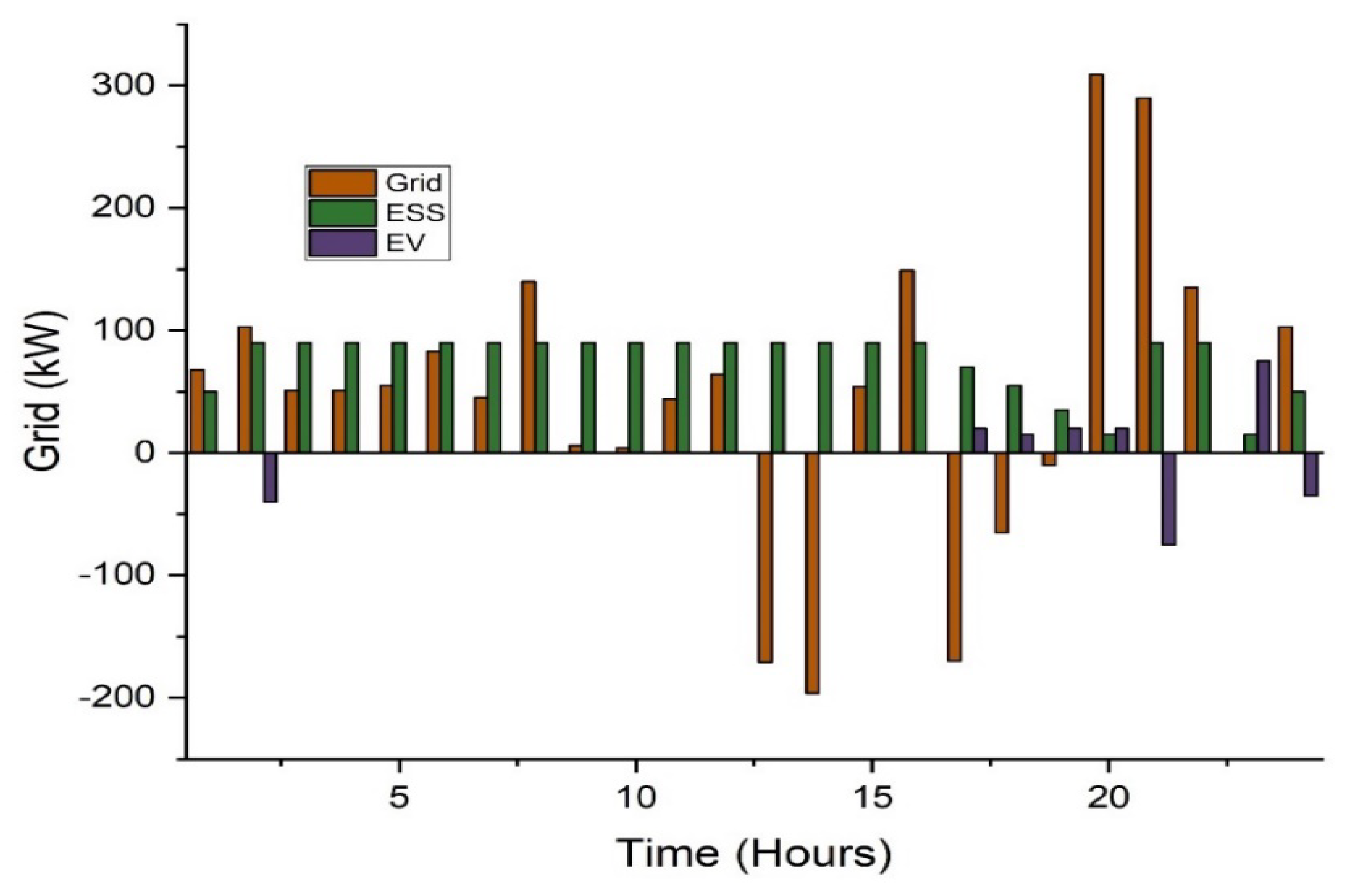
| Scenarios | Grid Availability | Solar PV | BESS and EV |
|---|---|---|---|
| Case (01) RTP Case (02) CPP Case (03) ToU | ✓ | - | - |
| ✓ | ✓ | - | |
| ✓ | ✓ | ✓ | |
| Proposed Scheduling (Incentivized 10%) | ✓ | ✓ | ✓ |
| Scenarios | Cost Grid Availability (USD) | Cost Solar PV (USD) | BESS and EV | Saving (%) | |
|---|---|---|---|---|---|
| Case (01) RTP | i. | 797.31 | - | - | - |
| ii. | 394 | - | 50 | ||
| iii. | 354 | 55 | |||
| Proposed Scheduling (Incentivized 10%) | 717 | 355 | 301 | 58 | |
| Scenarios | Cost Grid Availability (USD) | Cost Solar PV (USD) | BESS and EV | Saving (%) | |
|---|---|---|---|---|---|
| Case (02) CPP | i. | 1002 | - | - | - |
| ii. | 489 | - | 51 | ||
| iii. | 480 | 52 | |||
| Proposed Scheduling (Incentivized 10%) | 902 | 440 | 451 | 55 | |
| Scenarios | Cost Grid Availability (USD) | Cost Solar PV (USD) | BESS and EV | Saving (%) | |
|---|---|---|---|---|---|
| Case (03) ToU | i. | 918.54 | - | - | - |
| ii. | 565 | - | 38 | ||
| iii. | 526 | 42 | |||
| Proposed Scheduling (Incentivized 10%) | 826 | 508 | 498 | 45 | |
| Ref. | Year | Application | Technique | Remarks | Savings |
|---|---|---|---|---|---|
| [74] | 2018 | Campus µG | MILP | Peak demand | 5.32% |
| [75] | 2018 | Residential Level | MILP | Frequency-based regulation | 7% |
| [76] | 2019 | Residential µG | LP | Grid for the mode of outage | 16% |
| [77] | 2020 | Campus µG | MILP | Peak mitigation | 23% |
| [78] | 2021 | Campus µG | MILP | ESS degradation cost, peak demand | 5.27% |
| Proposed Model | 2022 | Campus µG | LP | ESS, Demand response, EV | 58% |
Publisher’s Note: MDPI stays neutral with regard to jurisdictional claims in published maps and institutional affiliations. |
© 2022 by the authors. Licensee MDPI, Basel, Switzerland. This article is an open access article distributed under the terms and conditions of the Creative Commons Attribution (CC BY) license (https://creativecommons.org/licenses/by/4.0/).
Share and Cite
Fei, L.; Shahzad, M.; Abbas, F.; Muqeet, H.A.; Hussain, M.M.; Bin, L. Optimal Energy Management System of IoT-Enabled Large Building Considering Electric Vehicle Scheduling, Distributed Resources, and Demand Response Schemes. Sensors 2022, 22, 7448. https://doi.org/10.3390/s22197448
Fei L, Shahzad M, Abbas F, Muqeet HA, Hussain MM, Bin L. Optimal Energy Management System of IoT-Enabled Large Building Considering Electric Vehicle Scheduling, Distributed Resources, and Demand Response Schemes. Sensors. 2022; 22(19):7448. https://doi.org/10.3390/s22197448
Chicago/Turabian StyleFei, Liu, Muhammad Shahzad, Fazal Abbas, Hafiz Abdul Muqeet, Muhammad Majid Hussain, and Li Bin. 2022. "Optimal Energy Management System of IoT-Enabled Large Building Considering Electric Vehicle Scheduling, Distributed Resources, and Demand Response Schemes" Sensors 22, no. 19: 7448. https://doi.org/10.3390/s22197448
APA StyleFei, L., Shahzad, M., Abbas, F., Muqeet, H. A., Hussain, M. M., & Bin, L. (2022). Optimal Energy Management System of IoT-Enabled Large Building Considering Electric Vehicle Scheduling, Distributed Resources, and Demand Response Schemes. Sensors, 22(19), 7448. https://doi.org/10.3390/s22197448









